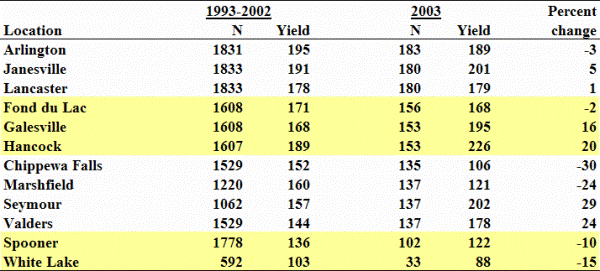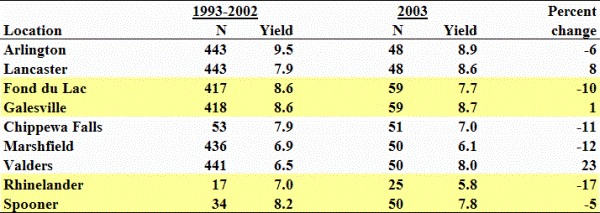
Looking Back on Corn Production in 2003
December 11, 2003 10(27):200-201
Joe Lauer, Corn Agronomist
The corn production year of 2003 had extreme drought in the southwestern quadrant
of Wisconsin. Little rain fell from mid-July through August. Grain and silage yields
were quite variable. Both grain and silage yields were above normal in northeastern
Wisconsin (Valders and Seymour). Spring planting conditions were good until May
4 after which conditions were cooler and dryer than average. Plant emergence and
stands were above average and the condition of the crop looked good through the
end of July. Corn development was somewhat behind average due to cool early growing
conditions, but development caught up and was average by mid-July due to hot, dry
conditions. Dry, hot weather during pollination lowered yields in southwestern Wisconsin,
especially for late-planted corn and longer-season relative maturity hybrids. Growing
degree unit accumulation was slightly behind average throughout the entire growing
season. Corn silage harvest began earlier than normal on sites affected by the drought.
A killing frost did not occur until early-October. Plant standability was poor in
drought affected trials. During the fall harvest season, yields were generally good,
and moisture was low decreasing drying costs.
Table 1. Summary of the 2003 corn hybrid performance trials for grain yield (bu/A)
conducted at twelve locations in Wisconsin. N= number of hybrids tested.

Table 2. Summary of the 2003 corn hybrid performance trials for silage yield (T/A)
conducted at nine locations in Wisconsin. N = number of hybrids tested.

Corn grain yields in the UW Corn Hybrid Performance trials were average to below
average in most locations around the state (Table 1). During 2003 Galesville, Seymour,
Valders and Hancock (irrigated) had 16 to 29 percent yield increases over the average
of the ten-year period from 1993 to 2002. Chippewa Falls and Marshfield were especially
hard hit with drought yielding 24 to 30 percent below the average of the previous
ten years. No hybrid performance records were established at any site in 2003.
Corn silage yields in the UW Corn Hybrid Performance trials reflected what occurred
in the grain trials (Table 2). Nearly all sites were average to below average, however,
at Valders silage yields were 23 percent above the average of the previous ten-year
period from 1993 to 2002.